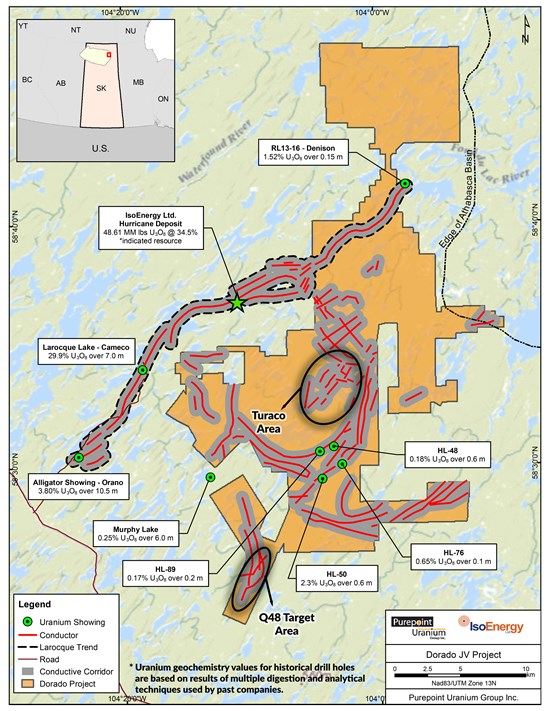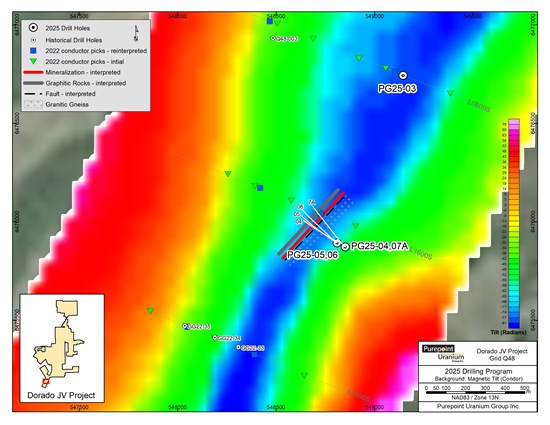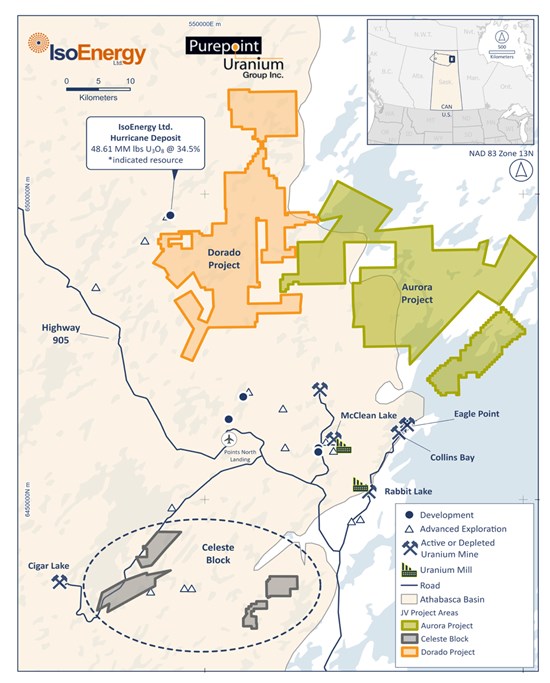IsoEnergy and Purepoint Extend High-Grade Mineralization at the Dorado JV with a 70 Metre Step-Out Peaking at 110,800 CPS
IsoEnergy (NYSE: ISOU) and Purepoint Uranium (OTCQB: PTUUF) have reported significant drilling results from their 50/50 Dorado joint venture project in Saskatchewan's Athabasca Basin. The latest drill hole, PG25-07A, extended the "Nova Discovery" at the Q48 target by 70 metres northeast, revealing strong uranium mineralization averaging 11,100 CPS over 14.0 metres, with a peak reading of 110,800 CPS.
The mineralization remains open to the northeast, where radioactivity is increasing, but drilling has been temporarily paused due to wet marsh conditions. The joint venture partners have approved a 5,400-metre drill program for 2025, with operations now moving to the Turaco target, located 8 km northeast of Q48, where up to four holes are planned.
IsoEnergy (NYSE: ISOU) e Purepoint Uranium (OTCQB: PTUUF) hanno comunicato risultati significativi dai loro sondaggi nel progetto congiunto Dorado, in cui detengono una partecipazione al 50%, situato nella regione di Athabasca, Saskatchewan. L'ultimo foro di sondaggio, PG25-07A, ha esteso la "Scoperta Nova" nell'area Q48 di 70 metri verso nord-est, mostrando una mineralizzazione di uranio intensa con una media di 11.100 CPS su 14,0 metri e un picco di 110.800 CPS.
La mineralizzazione rimane aperta verso nord-est, dove la radioattività aumenta, ma i lavori di perforazione sono stati temporaneamente sospesi a causa delle condizioni di palude umida. I partner del progetto congiunto hanno approvato un programma di perforazione di 5.400 metri per il 2025, con le operazioni ora spostate verso l'obiettivo Turaco, situato a 8 km a nord-est di Q48, dove sono previsti fino a quattro fori di sondaggio.
IsoEnergy (NYSE: ISOU) y Purepoint Uranium (OTCQB: PTUUF) han reportado resultados significativos de perforación en su proyecto conjunto Dorado, con participación del 50/50, ubicado en la Cuenca de Athabasca, Saskatchewan. El último pozo de perforación, PG25-07A, extendió el "Descubrimiento Nova" en el objetivo Q48 hacia el noreste por 70 metros, revelando una mineralización fuerte de uranio con un promedio de 11,100 CPS sobre 14.0 metros, y un pico de 110,800 CPS.
La mineralización permanece abierta hacia el noreste, donde la radioactividad está aumentando, pero la perforación se ha detenido temporalmente debido a condiciones de pantano húmedo. Los socios del proyecto conjunto han aprobado un programa de perforación de 5,400 metros para 2025, y las operaciones se trasladan ahora al objetivo Turaco, ubicado a 8 km al noreste de Q48, donde se planean hasta cuatro pozos.
IsoEnergy (NYSE: ISOU)와 Purepoint Uranium (OTCQB: PTUUF)는 사스카치완 주 애서배스카 분지에 위치한 50/50 공동 투자 프로젝트인 Dorado에서 중요한 시추 결과를 보고했습니다. 최근 시추공 PG25-07A는 Q48 목표지점의 "노바 발견"을 북동쪽으로 70미터 확장했으며, 평균 14.0미터 구간에서 11,100 CPS의 강한 우라늄 광화 현상과 최고 기록 110,800 CPS를 나타냈습니다.
광화는 북동쪽으로 열려 있으며 방사능이 증가하고 있으나, 습지 조건으로 인해 시추 작업은 일시 중단되었습니다. 공동 투자 파트너들은 2025년을 위한 5,400미터 시추 프로그램을 승인했으며, 현재 작업은 Q48에서 북동쪽으로 8km 떨어진 Turaco 목표지점으로 이동하여 최대 네 개의 시추공을 계획 중입니다.
IsoEnergy (NYSE : ISOU) et Purepoint Uranium (OTCQB : PTUUF) ont annoncé des résultats significatifs de forage dans leur projet en coentreprise Dorado, détenu à 50/50, situé dans le bassin d'Athabasca en Saskatchewan. Le dernier forage, PG25-07A, a étendu la « découverte Nova » sur la cible Q48 de 70 mètres vers le nord-est, révélant une minéralisation en uranium importante avec une moyenne de 11 100 CPS sur 14,0 mètres et un pic à 110 800 CPS.
La minéralisation reste ouverte au nord-est, où la radioactivité augmente, mais le forage a été temporairement suspendu en raison de conditions marécageuses humides. Les partenaires de la coentreprise ont approuvé un programme de forage de 5 400 mètres pour 2025, les opérations se déplaçant désormais vers la cible Turaco, située à 8 km au nord-est de Q48, où jusqu'à quatre forages sont prévus.
IsoEnergy (NYSE: ISOU) und Purepoint Uranium (OTCQB: PTUUF) haben bedeutende Bohrergebnisse aus ihrem 50/50-Dorado-Joint-Venture-Projekt im Athabasca-Becken in Saskatchewan gemeldet. Das neueste Bohrloch, PG25-07A, verlängerte die "Nova-Entdeckung" am Ziel Q48 um 70 Meter nordöstlich und zeigte eine starke Uranmineralisierung mit einem Durchschnitt von 11.100 CPS über 14,0 Meter und einem Spitzenwert von 110.800 CPS.
Die Mineralisierung bleibt nach Nordosten offen, wo die Radioaktivität zunimmt, jedoch wurden die Bohrarbeiten aufgrund von nassen Moorbedingungen vorübergehend eingestellt. Die Partner des Joint Ventures haben ein 5.400 Meter Bohrprogramm für 2025 genehmigt, wobei die Arbeiten nun zum Turaco-Ziel verlagert werden, das 8 km nordöstlich von Q48 liegt und wo bis zu vier Bohrlöcher geplant sind.
- None.
- Drilling temporarily halted in the northeast direction due to wet marsh ground conditions
- All assays from the current program still pending
Insights
Strong step-out drilling results suggest significant scale potential for IsoEnergy/Purepoint's uranium discovery at Dorado.
The latest drilling results from the Dorado JV represent a significant technical achievement in uranium exploration. Hole PG25-07A, stepping out 70 meters from previous drilling, has delivered extremely encouraging radioactivity measurements averaging 11,100 CPS over a substantial 14-meter interval with peak readings of 110,800 CPS. For context, these readings significantly exceed typical background levels and suggest potentially high-grade uranium mineralization.
The geological context is particularly promising. The mineralization is developing as a steeply dipping, basement-hosted structure - similar to several world-class deposits in the Athabasca Basin. Critically, the strongest radioactivity appears in the northeast direction, exactly where the system remains open for expansion. The increasing thickness and intensity of mineralization in this step-out hole suggests the potential discovery of a substantial mineral system rather than an isolated occurrence.
Technically, the discovery remains at an early stage without chemical assays, but the radioactivity patterns are compelling evidence of uranium mineralization. The presence of pitchblende (a uranium oxide mineral) noted in the core provides additional confirmation. The exploration team has demonstrated excellent technical execution by successfully targeting the mineralized structure 60 meters below the unconformity - a challenging drilling target that requires precise planning.
The interruption of drilling due to ground conditions is a common seasonal challenge in the Athabasca Basin, but the planned winter follow-up when frozen conditions allow further testing represents a systematic approach to resource definition. The parallel advancement to the Turaco target 8km away shows a balanced exploration strategy that maintains momentum while awaiting optimal conditions to expand the Nova discovery.
Toronto, Ontario--(Newsfile Corp. - July 23, 2025) - IsoEnergy Ltd. (NYSE American: ISOU) (TSX: ISO) ("IsoEnergy") and Purepoint Uranium Group Inc. (TSXV: PTU) (OTCQB: PTUUF) ("Purepoint") are pleased to report continued strong results from drilling at their 50/50 Dorado joint venture project ("Dorado" or the "Project"), located in Saskatchewan's world-class Athabasca Basin (Figure 1). The most recent drill hole, PG25-07A, stepped out approximately 70 metres northeast of the "Nova Discovery" intercepts at the Q48 target area and returned stronger mineralization, with an average of 11,100 counts per second (CPS) measured on a Mount Sopris 2PGA-1000 downhole radiometric probe across a much wider interval of 14.0 metres, including a peak reading of 110,800 CPS.
The recent Nova Discovery results further define the mineralized trend at the Q48 target as a steeply dipping, uranium-bearing structure hosted within the basement rocks, underscoring the potential scale and strength of the system emerging at Dorado. All assays from the current program, including holes PG25-04 and PG25-05, are pending on a rush basis and will be disclosed once available.
Highlights
PG25-07A intersected a continuation of the Nova Discovery uranium basement hosted mineralization approximately 70 metres northeast of PG25-05 and 60 metres below the unconformity, averaging 11,100 CPS over 14.0 metres with a peak of 110,100 CPS.
The Nova Discovery mineralization at Q48 remains open to the northeast, the direction of increasing radioactivity, but wet marsh ground conditions currently prevent further drilling in that direction. Follow-up drilling is expected to resume this winter, when frozen ground allows for more efficient land-based access.
The drill rig has now been mobilized to the Turaco target, located approximately 8 km northeast of the Q48 target within the Dorado project. Up to four holes are planned at Turaco as part of the 5,400-metre drill program approved by the joint venture partners for 2025.
"The recent Nova Discovery results underscore just how much potential remains at Dorado," said Chris Frostad, President and CEO of Purepoint Uranium. "PG25-07A has successfully extended the Nova Discovery zone by 70 metres and delivered our strongest intercept to date, both in intensity and thickness based on radioactivity. The systematic way we've approached Q48 is paying off, and we expect the next phase of drilling will push this discovery even further."
"The results from PG25-07A mark a significant leap forward for our new Nova discovery," added Philip Williams, CEO and Director of IsoEnergy. "This step-out hole shows that the mineralized structure continues northeast and that the grades and thickness are improving as we move along the trend. While we have had to pause advancement in this direction due to ground conditions, we are eager to return this winter to continue following what we believe is shaping up to be an exciting discovery."
DDHs PG25-06 and PG25-07A
Drill hole PG25-06 targeted the brittle fault associated with mineralization (Figure 1) at the unconformity approximately 20 metres northeast of initial drilling (Figure 2). The drill hole was collared with a dip of -64 degrees and encountered Athabasca sandstone to a depth of 316 metres. Granitic gneiss displaying paleoweathering alteration was drilled to 341 metres then generally unaltered granite, pegmatites and pelitic gneiss was drilled to the completion depth of 482 metres. Projection of the Nova Discovery zone mineralization suggests the radioactive sandstone interval of 1,040 cps over 2.3 metres in the Mount Sopris 2PGA-1000 downhole gamma probe (Table 1), which occurs within core lost between 312.4 to 314.0m, is related to the primary mineralized structure.
Hole PG25-07A was collared from the PG25-04 drill pad and initial deviation resulted in a large 70 metre step out to the northeast of the PG25-05 mineralized intercept. The unconformity was intersected at a depth of 322 metres and the drill hole intercepted the radioactive structure approximately 40 metres up-dip of PG25-04. From the unconformity, granitic gneiss with pegmatitic intervals was encountered to a depth of 392 metres that was initially clay altered for 5 metres, weakly chlorite altered for 20 metres, unaltered for 36 metres, then became chloritized and silicified for 9 metres. Chloritized pelitic gneiss was drilled from 392 to 441 metres, unaltered graphitic and pyritic pelitic gneiss to 459 metres, followed by unaltered granitic gneiss and pegmatites with minor pelitic gneiss to the completion depth of 548 metres.
The PG25-07A Nova zone mineralization starts within granitic gneiss at 382.3 metres and extends into pelitic gneiss to a depth of 396.3 metres returning an average of 11,100 cps over 14.0 metres. A primary mineralized structure of the Nova zone is hosted in sheared, reddish-brown altered granitic gneiss with pitchblende that returned an average of 82,300 cps over 0.6 metres with a peak of 110,800 cps. A second strongly mineralized interval occurs within lost pelitic gneiss core and returned an average of 46,000 cps over 0.4 metres.
Figure 1: Location of the Q48 and Turaco Target areas, the initial focus of the 2025 drill program, highlighted.
* See Qualified Person Statement below.
To view an enhanced version of this graphic, please visit:
https://images.newsfilecorp.com/files/3218/259695_2fe549fc14a74947_003full.jpg
Figure 2: Location Map of 2025 Drill Program at Q48 Target Area and the new Nova Discovery.
To view an enhanced version of this graphic, please visit:
https://images.newsfilecorp.com/files/3218/259695_2fe549fc14a74947_004full.jpg
Table 1: Downhole Gamma Results of Drill Holes PG25-06 and 07A
| Hole ID | From (m) | To (m) | Length (m) | Avg. cps | Max. cps |
| PG25-06 | 250.8 | 251.5 | 0.7 | 665 | 805 |
| 312.6 | 314.9 | 2.3 | 1,040 | 1,770 | |
| 341.2 | 345.3 | 4.1 | 980 | 1,980 | |
| 347.6 | 348.4 | 0.8 | 860 | 1,060 | |
| 351.4 | 353.1 | 1.7 | 910 | 1,320 | |
| 403.3 | 404.7 | 1.4 | 1,410 | 2,600 | |
| PG25-07A | 382.3 | 396.3 | 14.0 | 11,100 | 110,800 |
| Includes | 385.5 | 386.1 | 0.6 | 82,300 | |
| Includes | 392.3 | 392.7 | 0.4 | 46,000 | |
| 397.4 | 399.8 | 2.4 | 4,500 | 20,200 | |
| 401.5 | 402.8 | 1.3 | 6,200 | 21,500 | |
| Includes | 402.0 | 402.4 | 0.4 | 14,400 | |
| 484.4 | 484.9 | 0.5 | 1,720 | 3,680 | |
| Note: Mt. Sopris 2PGA probe used to record downhole gamma readings | |||||
Q48 Target Area
The Q48 zone lies within the southern portion of the Project and is characterized by a steeply dipping, north-south trending conductive package identified through geophysical surveys. Historic drilling in the area intersected strongly altered and structurally disrupted rocks at the unconformity and in the basement, including garnetiferous pelitic gneiss, graphitic pelitic gneiss, and semipelite, with local weak radioactivity and zones of intense clay alteration. These results, combined with the geophysical response, highlighted Q48 as a highly prospective but underexplored target.
Drilling by IsoEnergy in 2022 confirmed that the conductive trend at Q48 hosts brittle faults, shears, and alteration, characteristics of uranium-bearing hydrothermal systems in the Athabasca Basin. The current program is designed to systematically follow-up and fully test the Q48 conductive corridor.
Turaco Target Area
The Turaco zone lies within the central portion of the Project and is characterized by a broad area with high conductivity. Although numerous geophysical surveys have been conducted, including airborne electromagnetics (VTEM), ground EM, induced polarization and gravity, previous drilling has failed to properly explain the interpreted EM conductors. A recent review of the geophysical results by Condor Consulting North of Vancouver, BC has selected alternative EM conductor picks that better explain the conductive responses and used Maxwell Modeling to accurately locate the position of discreet conductors. Drilling will commence at one of the high priority target areas identified by Condor.
About the Dorado JV Project
Dorado (Figure 3) is the flagship project of the IsoEnergy-Purepoint 50/50 joint venture, a partnership encompassing more than 98,000 hectares of prime uranium exploration ground. The Project includes the former Turnor Lake, Geiger, Edge, and Full Moon properties, all underlain by graphite-bearing lithologies and fault structures favorable for uranium deposition.
Recent drilling by IsoEnergy east of the Hurricane Deposit has intersected strongly elevated radioactivity in multiple holes. The anomalous radioactivity confirms the continuity of fertile graphitic rock package and further highlights the opportunity for additional high-grade discoveries across the region.
The shallow unconformity depths across the Dorado property-typically between 30 and 300 metres-allow for highly efficient drilling and rapid follow-up on results.
Figure 3: IsoEnergy and Purepoint Uranium Joint Venture including, Dorado Project, Aurora Project and Celeste Block
* See Qualified Person Statement below.
To view an enhanced version of this graphic, please visit:
https://images.newsfilecorp.com/files/3218/259695_2fe549fc14a74947_005full.jpg
Gamma Logging and Geochemical Assaying
A Mount Sopris 2PGA-1000 downhole total gamma probe was utilized for radiometric surveying. The total gamma results provided in Table 1 were selected using a cutoff of 500 cps over a 0.5 metre width. All drill intercepts are core width and true thickness is yet to be determined.
Core samples are submitted to the Saskatchewan Research Council (SRC) Geoanalytical Laboratories in Saskatoon. The SRC facility is independent of IsoEnergy and PurePoint and is ISO/IEC 17025:2005 accredited by the Standards Council of Canada (scope of accreditation #537). The samples are analyzed for a multi-element suite using partial and total digestion inductively coupled plasma methods, for boron by Na2O2 fusion, and for uranium by fluorimetry.
Qualified Person Statement
The scientific and technical information contained in this news release relating to IsoEnergy and Purepoint was reviewed and approved by Dr. Dan Brisbin, P.Geo., IsoEnergy's Vice President, Exploration and Scott Frostad BSc, MASc, P.Geo., Purepoint's Vice President, Exploration, who are "Qualified Persons" (as defined in NI 43-101 - Standards of Disclosure for Mineral Projects ("NI 43-101")).
For additional information with respect to the current mineral resource estimate for IsoEnergy's Hurricane Deposit, please refer to the Technical Report prepared in accordance with NI 43-101 entitled "Technical Report on the Larocque East Project, Northern Saskatchewan, Canada" dated August 4, 2022, available under IsoEnergy's profile at www.sedarplus.ca.
This news release refers to properties other than those in which IsoEnergy and Purepoint have an interest. Mineralization on those other properties is not necessarily indicative of mineralization on the Joint Venture properties.
About IsoEnergy Ltd.
IsoEnergy (NYSE American: ISOU) (TSX: ISO) is a leading, globally diversified uranium company with substantial current and historical mineral resources in top uranium mining jurisdictions of Canada, the U.S. and Australia at varying stages of development, providing near-, medium- and long-term leverage to rising uranium prices. IsoEnergy is currently advancing its Larocque East project in Canada's Athabasca basin, which is home to the Hurricane deposit, boasting the world's highest-grade indicated uranium mineral resource. IsoEnergy also holds a portfolio of permitted past-producing, conventional uranium and vanadium mines in Utah with a toll milling arrangement in place with Energy Fuels. These mines are currently on standby, ready for rapid restart as market conditions permit, positioning IsoEnergy as a near-term uranium producer.
About Purepoint
Purepoint Uranium Group Inc. (TSXV: PTU) (OTCQB: PTUUF) is a focused explorer with a dynamic portfolio of advanced projects within the renowned Athabasca Basin in Canada. Highly prospective uranium projects are actively operated on behalf of partnerships with industry leaders including Cameco Corporation, Orano Canada Inc. and IsoEnergy Ltd.
Additionally, the Company holds a promising VMS project currently optioned to and strategically positioned adjacent to and on trend with Foran Mining Corporation's McIlvenna Bay project. Through a robust and proactive exploration strategy, Purepoint is solidifying its position as a leading explorer in one of the globe's most significant uranium districts.
For more information, please contact:
IsoEnergy Ltd.
Philip Williams, CEO and Director
(833) 572-2333
info@isoenergy.ca
www.isoenergy.ca
Purepoint Uranium Group Inc.
Chris Frostad, President & CEO
Phone: (416) 603-8368
Email: cfrostad@purepoint.ca
Neither the Exchange nor its Regulation Services Provider (as that term is defined in the policies of the Exchange) accepts responsibility for the adequacy or accuracy of this Press release.
Cautionary Statement Regarding Forward-Looking Information
This press release contains "forward-looking information" within the meaning of applicable Canadian securities legislation. Generally, forward-looking information can be identified by the use of forward-looking terminology such as "plans", "expects" or "does not expect", "is expected", "budget", "scheduled", "estimates", "forecasts", "intends", "anticipates" or "does not anticipate", or "believes", or variations of such words and phrases or state that certain actions, events or results "may", "could", "would", "might" or "will be taken", "occur" or "be achieved". This forward-looking information may relate to additional planned exploration activities, including the timing thereof and the anticipated results thereof; and any other activities, events or developments that the companies expect or anticipate will or may occur in the future.
Forward-looking statements are necessarily based upon a number of assumptions that, while considered reasonable by management at the time, are inherently subject to business, market and economic risks, uncertainties and contingencies that may cause actual results, performance or achievements to be materially different from those expressed or implied by forward-looking statements. Such assumptions include, but are not limited to, that planned exploration activities are completed as anticipated; the anticipated costs of planned exploration activities, the price of uranium; that general business and economic conditions will not change in a materially adverse manner; that financing will be available if and when needed and on reasonable terms; and that third party contractors, equipment and supplies and governmental and other approvals required to conduct the Joint Venture's planned activities will be available on reasonable terms and in a timely manner. Although each of IsoEnergy and Purepoint have attempted to identify important factors that could cause actual results to differ materially from those contained in forward-looking information, there may be other factors that cause results not to be as anticipated, estimated or intended. There can be no assurance that such information will prove to be accurate, as actual results and future events could differ materially from those anticipated in such statements. Accordingly, readers should not place undue reliance on forward-looking information.
Such statements represent the current views of IsoEnergy and Purepoint with respect to future events and are necessarily based upon a number of assumptions and estimates that, while considered reasonable by IsoEnergy and Purepoint, are inherently subject to significant business, economic, competitive, political and social risks, contingencies and uncertainties. Risks and uncertainties include but are not limited to the following: the inability of the Joint Venture to complete the exploration activities as currently contemplated; ; uncertainty of additional financing; no known mineral resources or reserves; aboriginal title and consultation issues; reliance on key management and other personnel; actual results of technical work programs and technical and economic assessments being different than anticipated; regulatory determinations and delays; stock market conditions generally; demand, supply and pricing for uranium; and general economic and political conditions. Other factors which could materially affect such forward-looking information are described in the risk factors in each of IsoEnergy's and Purepoint's most recent annual management's discussion and analyses or annual information forms and IsoEnergy's and Purepoint's other filings with the Canadian securities regulators which are available, respectively, on each company's profile on SEDAR+ at www.sedarplus.ca. IsoEnergy and Purepoint do not undertake to update any forward-looking information, except in accordance with applicable securities laws.

To view the source version of this press release, please visit https://www.newsfilecorp.com/release/259695










